How Does a Brown Butterfly Symbolize in Your Life?
Brown butterflies symbolize profound transformation, resilience, and a grounded connection to both nature and the spiritual domain. Their metamorphosis signifies personal growth and self-improvement, while their earthy brown hues evoke stability and a deep-rooted connection to the physical world.
Culturally, they serve as messengers in various traditions, reflecting ancestral messages, life's cycles, and spiritual evolution. Brown butterflies also epitomize the importance of grounding and introspection, encouraging alignment with one's authentic self.
For those intrigued by the intricate symbolism and cultural significance of brown butterflies, further exploration into their profound meanings awaits.
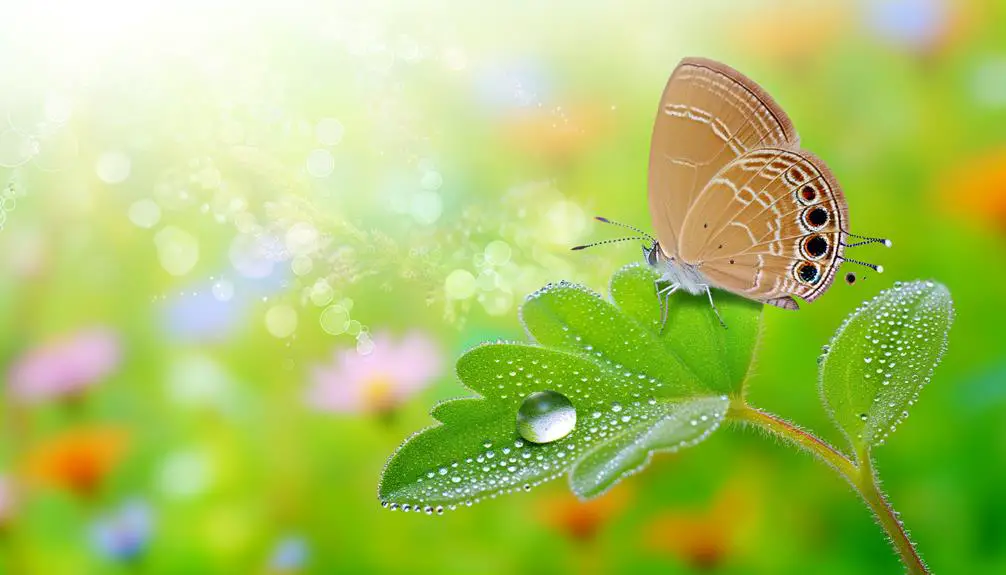
Key Takeaways
- Brown butterflies symbolize personal transformation and profound change.
- They represent grounding and stability, reminding individuals of their core values.
- In many cultures, they are seen as messengers of ancestral or spiritual guidance.
- They embody a deep connection to nature and emphasize ecological mindfulness.
Spiritual Meanings
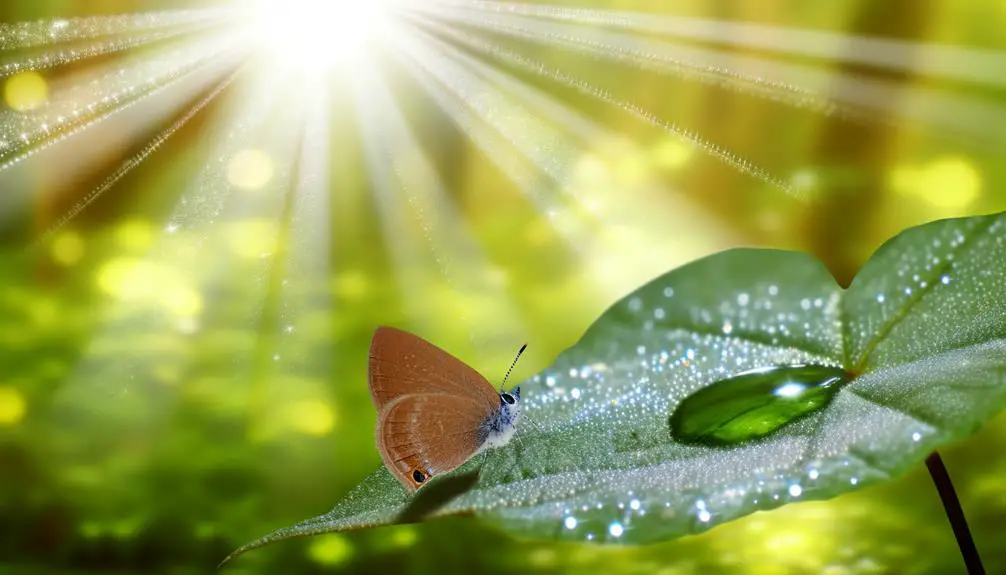
In various cultural and spiritual traditions, brown butterflies are often seen as symbols of transformation, grounding, and a connection to the earth. This perception stems from their subtle, earthy tones, which evoke a sense of stability and resilience.
Spiritually, the brown butterfly's metamorphosis from caterpillar to adult signifies profound personal change and self-improvement. Grounding, a key element in many spiritual practices, is attributed to the brown butterfly's natural, terrestrial colors, suggesting a balanced connection to the physical world.
Additionally, the brown butterfly's life cycle resonates with themes of rebirth and renewal, encouraging reflection on one's journey and growth. This symbolism underscores the butterfly's role as a spiritual guide, fostering a deeper understanding of life's continuous evolution.
Cultural Significance
In various cultural contexts, the brown butterfly holds significant symbolic meanings, often rooted in folklore, traditions, and rituals.
For instance, in some Indigenous cultures, the appearance of a brown butterfly is interpreted as a messenger from the spiritual domain, conveying important omens or guidance.
Additionally, in Eastern traditions, brown butterflies are sometimes seen as symbols of transformation and resilience, reflecting the intricate relationship between humans and the natural world.
Symbolism in Folklore
Folklore from various cultures often imbues the brown butterfly with profound symbolism, representing transformation, resilience, and the bridging of earthly and spiritual domains. These delicate creatures have been interpreted through diverse cultural lenses, each attributing unique meanings to their presence. In many Native American traditions, brown butterflies symbolize a message from ancestors, indicating a protective spiritual presence. In Celtic folklore, they represent the soul's journey and metamorphosis. Meanwhile, in Japanese culture, brown butterflies are seen as symbols of change and personal growth.
| Culture | Symbolism |
|---|---|
| Native American | Ancestral messages, protection |
| Celtic | Soul's journey, metamorphosis |
| Japanese | Change, personal growth |
| Mexican | Spiritual transformation, resilience |
Understanding these interpretations provides insight into how the brown butterfly serves as a potent symbol across various traditions. This symbolism highlights the deep connection between nature and human beliefs, where even the simplest creatures carry profound meanings. Similarly, red butterfly symbolism often represents transformation, passion, and powerful spiritual messages in different cultures. By exploring these interpretations, we gain a deeper appreciation for the ways in which butterflies, regardless of color, convey significant themes of change and renewal.
Traditions and Rituals
Across various cultures, the brown butterfly is integral to numerous traditions and rituals, each embedding it with significant cultural and spiritual symbolism.
In Native American cultures, the brown butterfly often represents transformation and the cyclical nature of life, playing a role in ceremonies that honor seasonal changes.
In Mexican traditions, brown butterflies are seen as messengers from the deceased, particularly during Día de los Muertos, where they symbolize the presence of loved ones.
Similarly, in Japanese culture, the brown butterfly is a harbinger of renewal and personal growth, often incorporated into rituals aimed at self-improvement.
These cultural contexts highlight the brown butterfly's universal symbolism of change, continuity, and the interconnectedness of life and death.
Grounding and Stability
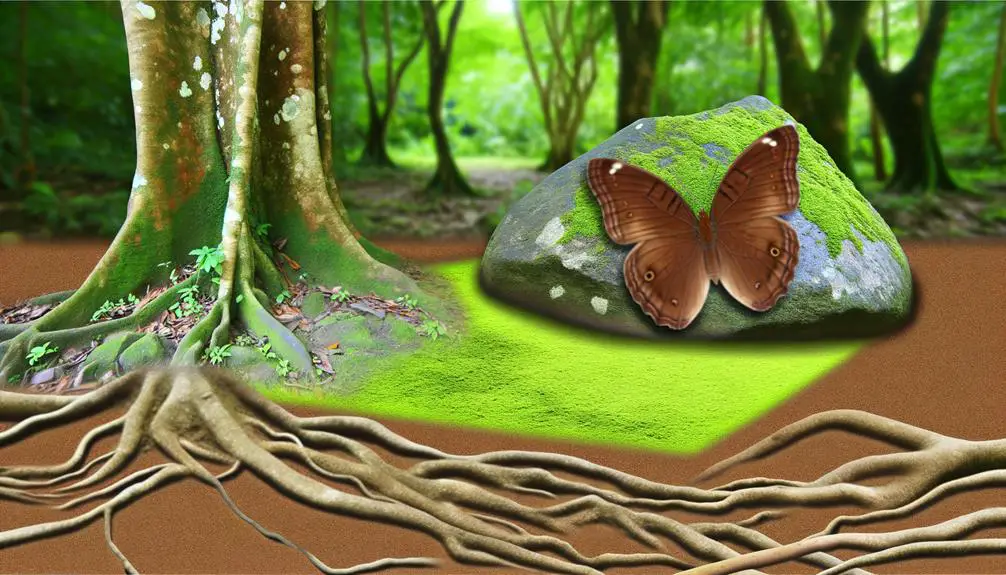
The brown butterfly, often associated with the earth and its foundational qualities, symbolizes grounding and stability, offering a profound reminder of the importance of staying anchored to one's core values amidst life's turbulence.
In various cultures, this butterfly is seen as a totem of resilience and steadfastness, reflecting the strength derived from a deep connection to the earth. The brown hue, evoking soil and roots, underscores the necessity of a stable foundation for personal growth.
Analyzing its symbolism, one finds that the brown butterfly encourages introspection and alignment with one's authentic self. It serves as a gentle nudge to remain unwavering in one's principles, providing a sense of security and balance in an ever-changing world.
Connection to Nature
Building upon the theme of grounding and stability, the brown butterfly's symbolism extends further to a profound connection to nature, embodying the intrinsic bond between human beings and the natural world.
Historically, brown butterflies have been seen as messengers of the earth, emphasizing the symbiotic relationship humans share with their environment.
Their earthy tones reflect the soil and trees, elements fundamental to life and growth.
In many cultures, the brown butterfly is a reminder to stay attuned to natural cycles and rhythms, fostering respect and harmony with the ecosystem.
This connection underscores the importance of environmental stewardship, reminding us that our well-being is intertwined with the health of the planet.
Consequently, the brown butterfly serves as a potent emblem of ecological mindfulness.
Personal Transformation
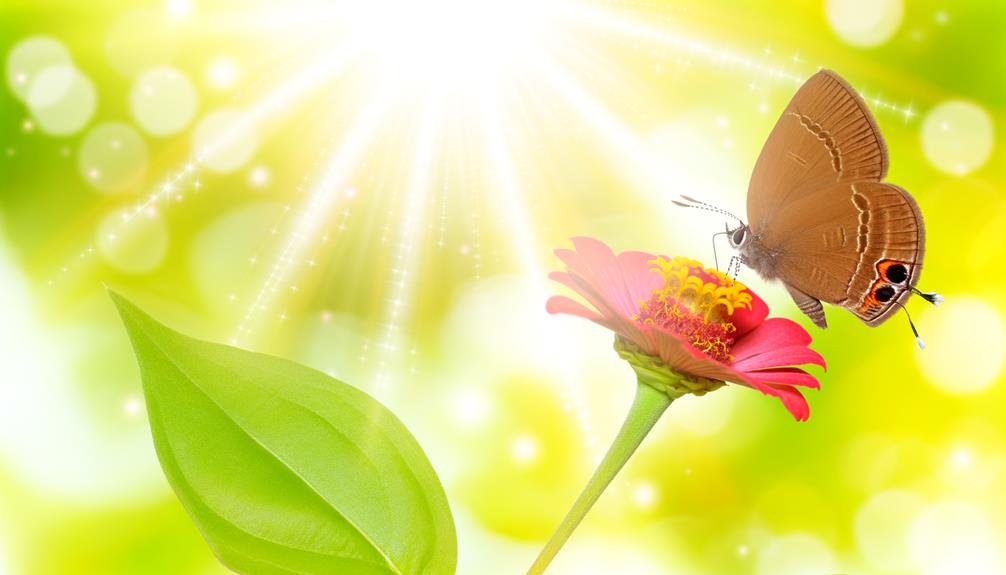
Symbolizing personal transformation, the brown butterfly represents the journey of growth and change that individuals undergo throughout their lives.
Within various cultural contexts, this transformation is analogous to the butterfly's metamorphosis—from a caterpillar to a winged creature. The brown hue, often associated with groundedness and stability, underlines the necessity of inner reflection and resilience during periods of personal evolution.
Psychologically, encountering a brown butterfly can signify a pivotal moment of self-awareness and an invitation to embrace change.
Historically, many cultures have revered butterflies as symbols of the soul's journey and metamorphosis. Consequently, the brown butterfly embodies the profound, often challenging, process of personal transformation, urging individuals to evolve while remaining connected to their foundational roots.
Encounter Interpretations
Understanding the implications of encountering a brown butterfly requires an exploration of various cultural interpretations and psychological insights.
In many traditions, a brown butterfly is seen as a harbinger of change or a spiritual message. For instance, Native American cultures often regard it as a symbol of endurance and transformation, reflecting the creature's metamorphic lifecycle.
Psychologically, such encounters might evoke introspection, urging individuals to reflect on their life phases and inner transformations.
Additionally, in certain Eastern philosophies, the brown butterfly is linked to grounding and stability, encouraging balance amid life's tumultuous changes.
Conclusion
The brown butterfly, juxtaposed as both a symbol of grounding and spiritual transformation, encapsulates a profound duality.
Its cultural significance spans diverse societies, where it embodies stability yet heralds personal metamorphosis.
This delicate creature, deeply intertwined with nature, serves as a reminder of the interconnectedness of all life.
Each encounter with a brown butterfly invites reflection on personal growth and the enduring balance between the material and spiritual domains.





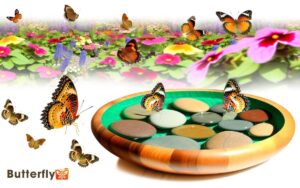

cqxaib
In this section, we’ll talk about their function in selling quicker recovery occasions and the way that
may be advantageous for individuals looking to optimize their exercise routines.
For optimum outcomes, it’s essential to plan and follow well-structured bulking and slicing
cycles. Sometimes, a bulking cycle lasts between eight to 12
weeks, specializing in consuming a surplus of energy and a
comprehensive coaching program that stimulates muscle development.
After completing a bulking cycle, a slicing cycle follows, ranging from four to
8 weeks, during which caloric intake is restricted and a proper workout regimen targets fats loss.
The handiest method to construct muscle is by combining a nutritious diet
with constant exercise and supplementation. This can help to
maximise muscle development whereas additionally selling total health and
wellness. There isn’t sufficient research to make a distinguishable vote of confidence that you could gain advantage from supplementing your food plan with prohormones.
It offers huge muscle positive aspects, but at a a lot greater risk than with the components of D-Bal.
Dbal is Loopy Bulk’s Top Authorized steroid alternative
to gain high quality muscular tissues and energy.
Several ingredients are incessantly used by each CrazyBulk and Classic Muscle
as a end result of their identified benefits in muscle building and testosterone help.
While the authorized steroids market continues to evolve, it’s essential to remain vigilant about the high quality and safety
of the merchandise. Always research and select respected brands
like Crazy Bulk to guarantee that you’re getting effective,
protected, and reliable supplements to support your fitness journey.
When it involves building quality muscle mass as quick as potential, there are 2 stacks from Muscle Labs USA authorized steroids you could select from.
Authorized steroids are anabolic supplements produced from one hundred pc pure
components that will offer you very related benefits to
that of the banned anabolic steroids. In right now’s fitness world, authorized steroids have turn out to be
more and more in style among weight lifters, looking for to realize higher outcomes in phrases of muscle development, strength, and endurance.
Lean muscles provide your physique with the ultimate form and
curves that you simply crave for. Loopy Bulk is an organization of legal steroids that render
explosive & enticing strength to the body. This energy is
equal whether you’re carrying out any sort of exercises as
these help in rapid recoveries. Loopy Bulk as its name indicates is the crazy creation that’s planned for fulfilling
the wants & preferences of people of all kinds. Even although legal steroids are protected to make use of,
there have been reports of some supplements containing illegal elements like Dimethylamylamine (DMAA).
D-Bal Max would not simply allow you to build muscle; it also aids in fat loss and improves muscle definition. This means you’re not just getting larger; you’re getting extra ripped
too.
In Contrast To steroids, TestoPrime helps your body produce
the optimum amount of testosterone on your age. Throughout the primary
week, I observed a gradual increase in my vitality ranges and an improvement in my sleeping sample.
Sustanon is a brand name for a mix of four testosterone esters used to deal with low testosterone levels in males.
After the primary few days, I began to experience increased stamina and vitality levels, although it is caffeine-free.
We prioritized supplements with aggressive pricing without sacrificing high
quality. We verified the amount of every ingredient to make sure protected and efficient dosages.
We solely recommend dietary supplements with components in quantities which have proven efficacy.
Anvarol is designed to exchange the steroid Anavar by offering related anabolic and thermogenic benefits whereas avoiding its opposed unwanted effects.
Other good traits to watch during a chopping cycle include growing cardio and general endurance coaching.
Cardio is great for consistently burning extra energy, reducing the quantity of energy your
physique tries to retain as fat. If you’re the type of person who prefers rules of thumb and eyeballing
a problem rather than exact solutions, there is a straightforward approach to go about this.
Make positive that no less than half of your meal, both by
plate size or by calorie depend, is protein. Lean protein like hen or turkey gives your body precisely what it wants for
building up higher, larger muscles. We’re going to cowl a
few of these effects intimately, to remind you why Crazy Bulk’s all natural alternate options are a much safer wager on your physical
health and exercise routine. These aren’t fillers and placebos, but real components chosen to have an active effect in your body’s metabolism and bulking processes.
To properly consider the D-Bal complement, we first need to look at
what the components are. Each compound, pure or otherwise, affects the body in a chemical method.
When deciding on supplements like CrazyBulk and Vintage Muscle, it’s necessary to recognize that not all dietary supplements are FDA
permitted. Authorized issues similar to ingredient legality and
company compliance with regulations are additionally
pertinent. The function of this section is to deal with common queries relating to
the usage of Classic Muscle and CrazyBulk supplements
and their implications for muscle-building efforts.
Ultimately, customers must scrutinize the label of any well being supplement for a
transparent understanding of its contents and potential side effects.
Present analysis suggests such herbs and amino acids exhibit constructive effects
on testosterone ranges (7); nonetheless, they’re unlikely
to cause distinctive elevations. Anecdotally, we’ve had bodybuilders report up to
12 lbs of muscle acquire, and others expertise no visible outcomes.
Thus, turkesterone’s outcomes might be dependent on the
quality of the supplement and whether or not the consumer is a hyperresponder.
I Am coming off one other minimize and cycled off for this 8 week however and altered my hygiene
habits and the zits has disappeared. I do advocate this product though
and have really helpful it to a couple people who asked.
However based on a model new examine published in JAMA, many merchandise containing SARMs yow will discover
online include unapproved substances, hormones, and
steroids. What’s extra, many of the labels slapped onto these dietary supplements are
fully misleading. D-Bal is also simple to implement into your workout routine and
helps you on the journey of carrying out your bodybuilding objectives in a natural
way.
References:
steroid perscription
As soon as I observed this web site I went on reddit to share some of the love with them.
https://www.zoritolerimol.com